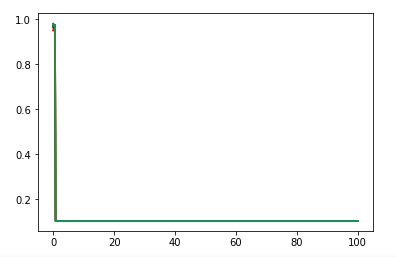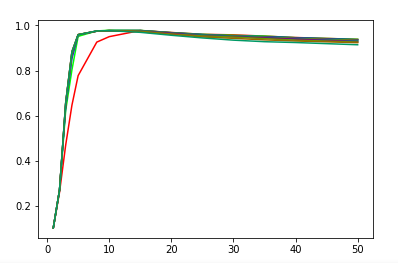吴裕雄 python 机器学习——半监督学习LabelSpreading模型
import numpy as np
import matplotlib.pyplot as plt from sklearn import metrics
from sklearn import datasets
from sklearn.semi_supervised.label_propagation import LabelSpreading def load_data():
'''
加载数据集
'''
digits = datasets.load_digits()
###### 混洗样本 ########
rng = np.random.RandomState(0)
indices = np.arange(len(digits.data)) # 样本下标集合
rng.shuffle(indices) # 混洗样本下标集合
X = digits.data[indices]
y = digits.target[indices]
###### 生成未标记样本的下标集合 ####
# 只有 10% 的样本有标记
n_labeled_points = int(len(y)/10)
# 后面 90% 的样本未标记
unlabeled_indices = np.arange(len(y))[n_labeled_points:]
return X,y,unlabeled_indices #半监督学习LabelSpreading模型
def test_LabelSpreading(*data):
X,y,unlabeled_indices=data
y_train=np.copy(y) # 必须拷贝,后面要用到 y
y_train[unlabeled_indices]=-1 # 未标记样本的标记设定为 -1
clf=LabelSpreading(max_iter=100,kernel='rbf',gamma=0.1)
clf.fit(X,y_train)
### 获取预测准确率
predicted_labels = clf.transduction_[unlabeled_indices] # 预测标记
true_labels = y[unlabeled_indices] # 真实标记
print("Accuracy:%f"%metrics.accuracy_score(true_labels,predicted_labels))
# 或者 print("Accuracy:%f"%clf.score(X[unlabeled_indices],true_labels)) # 获取半监督分类数据集
data=load_data()
# 调用 test_LabelSpreading
test_LabelSpreading(*data)

def test_LabelSpreading_rbf(*data):
'''
测试 LabelSpreading 的 rbf 核时,预测性能随 alpha 和 gamma 的变化
'''
X,y,unlabeled_indices=data
# 必须拷贝,后面要用到 y
y_train=np.copy(y)
# 未标记样本的标记设定为 -1
y_train[unlabeled_indices]=-1 fig=plt.figure()
ax=fig.add_subplot(1,1,1)
alphas=np.linspace(0.01,1,num=10,endpoint=True)
gammas=np.logspace(-2,2,num=50)
# 颜色集合,不同曲线用不同颜色
colors=((1,0,0),(0,1,0),(0,0,1),(0.5,0.5,0),(0,0.5,0.5),(0.5,0,0.5),(0.4,0.6,0),(0.6,0.4,0),(0,0.6,0.4),(0.5,0.3,0.2))
## 训练并绘图
for alpha,color in zip(alphas,colors):
scores=[]
for gamma in gammas:
clf=LabelSpreading(max_iter=100,gamma=gamma,alpha=alpha,kernel='rbf')
clf.fit(X,y_train)
scores.append(clf.score(X[unlabeled_indices],y[unlabeled_indices]))
ax.plot(gammas,scores,label=r"$\alpha=%s$"%alpha,color=color) ### 设置图形
ax.set_xlabel(r"$\gamma$")
ax.set_ylabel("score")
ax.set_xscale("log")
ax.legend(loc="best")
ax.set_title("LabelSpreading rbf kernel")
plt.show() # 调用 test_LabelSpreading_rbf
test_LabelSpreading_rbf(*data)

def test_LabelSpreading_knn(*data):
'''
测试 LabelSpreading 的 knn 核时,预测性能随 alpha 和 n_neighbors 的变化
'''
X,y,unlabeled_indices=data
# 必须拷贝,后面要用到 y
y_train=np.copy(y)
# 未标记样本的标记设定为 -1
y_train[unlabeled_indices]=-1 fig=plt.figure()
ax=fig.add_subplot(1,1,1)
alphas=np.linspace(0.01,1,num=10,endpoint=True)
Ks=[1,2,3,4,5,8,10,15,20,25,30,35,40,50]
# 颜色集合,不同曲线用不同颜色
colors=((1,0,0),(0,1,0),(0,0,1),(0.5,0.5,0),(0,0.5,0.5),(0.5,0,0.5),(0.4,0.6,0),(0.6,0.4,0),(0,0.6,0.4),(0.5,0.3,0.2))
## 训练并绘图
for alpha,color in zip(alphas,colors):
scores=[]
for K in Ks:
clf=LabelSpreading(kernel='knn',max_iter=100,n_neighbors=K,alpha=alpha)
clf.fit(X,y_train)
scores.append(clf.score(X[unlabeled_indices],y[unlabeled_indices]))
ax.plot(Ks,scores,label=r"$\alpha=%s$"%alpha,color=color) ### 设置图形
ax.set_xlabel(r"$k$")
ax.set_ylabel("score")
ax.legend(loc="best")
ax.set_title("LabelSpreading knn kernel")
plt.show() # 调用 test_LabelSpreading_knn
test_LabelSpreading_knn(*data)

吴裕雄 python 机器学习——半监督学习LabelSpreading模型的更多相关文章
- 吴裕雄 python 机器学习——半监督学习标准迭代式标记传播算法LabelPropagation模型
import numpy as np import matplotlib.pyplot as plt from sklearn import metrics from sklearn import d ...
- 吴裕雄 python 机器学习——层次聚类AgglomerativeClustering模型
import numpy as np import matplotlib.pyplot as plt from sklearn import cluster from sklearn.metrics ...
- 吴裕雄 python 机器学习——密度聚类DBSCAN模型
import numpy as np import matplotlib.pyplot as plt from sklearn import cluster from sklearn.metrics ...
- 吴裕雄 python 机器学习——支持向量机非线性回归SVR模型
import numpy as np import matplotlib.pyplot as plt from sklearn import datasets, linear_model,svm fr ...
- 吴裕雄 python 机器学习——KNN回归KNeighborsRegressor模型
import numpy as np import matplotlib.pyplot as plt from sklearn import neighbors, datasets from skle ...
- 吴裕雄 python 机器学习——KNN分类KNeighborsClassifier模型
import numpy as np import matplotlib.pyplot as plt from sklearn import neighbors, datasets from skle ...
- 吴裕雄 python 机器学习——支持向量机线性回归SVR模型
import numpy as np import matplotlib.pyplot as plt from sklearn import datasets, linear_model,svm fr ...
- 吴裕雄 python 机器学习——分类决策树模型
import numpy as np import matplotlib.pyplot as plt from sklearn import datasets from sklearn.model_s ...
- 吴裕雄 python 机器学习——回归决策树模型
import numpy as np import matplotlib.pyplot as plt from sklearn import datasets from sklearn.model_s ...
随机推荐
- windows安装python64位和32位的方法
1.先安装python 64位的 python,创建一个64位的python虚拟环境: 2.再安装python 32位的 python,创建一个32位的python虚拟环境即可. 注意:两个版本安装在 ...
- Python模块导入详解
定义 模块:用来从逻辑上组织Python代码(变量.函数.类.逻辑)去实现一个功能.本质就是.py结尾的Python文件. 包:用来从逻辑上组织模块的(可以放一堆模块在目录下).本质就是一个目录(必须 ...
- android 代码实现模拟用户点击、滑动等操作
/** * 模拟用户点击 * * @param view 要触发操作的view * @param x 相对于要操作view的左上角x轴偏移量 * @param y 相对于要操作view的左上角y轴偏移 ...
- sencha Architect 3.2及以下版本都适用的 破解方法
找到 没有的话 打开隐藏文件夹 C:\Users\ll\AppData\Local\Sencha\Sencha Architect 3.2 用编辑器 打开user.license 把 Print 修改 ...
- opencv:程序运行完保持dos窗口不关闭
(1)在main函数最后加上 system("pause"); 第一种不能加到含有imshow图片显示的结尾:否则会不能显示图片: (2)利用cvWaitKey()函数: 这种能加 ...
- OpenCV中imread失败cvLoadImage成功
MYLAF 环境说明 编程环境:Windows 10(64bit), VS2013, OpenCV 2.4.12; 编程语言:C/C++: MYLAF 现象 在代码中,调用imread读取图片失败,但 ...
- Codeforces Round #602 (Div. 2, based on Technocup 2020 Elimination Round 3) B Box
#include<bits/stdc++.h> using namespace std; ]; ]; int main() { int total; cin>>total; w ...
- 【Node】Webpack调试启动
"start": "webpack-dev-server --port 33333 --content-base ./dist",
- Django | 解决“(1146, "Table 'mydb.django_session' doesn't exist")”报错的方法
我只写了下面一行 就生成了session表 manage.py makemigrations sessions manage.py migrate sessions 参考:https://www.cn ...
- Dimension reduction
materials: 1. Dimension Reduction - IsoMap
